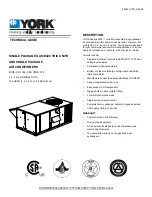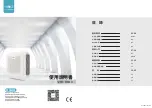
GB
F
D
14
I
2
2.1
INSTALLAZIONE
IDENTIFICAZIONE DELLE
PARTI PRINCIPALI (fig. 2)
1) Pannello comandi
2) Griglia di uscita dell’aria
3) Filtro dell’aria con griglia
4) Tappo per svuotamento
dell’acqua di condensa
5) Entrata dell’aria esterna
6) Uscita dell’aria esterna
7) Maniglia di spostamento
8) Vano per telecomando
AVVERTENZE
Installazione non corretta
(fig. 3)
Installazione corretta (fig. 4)
• Assicuratevi che tende o altri
oggetti non ostruiscano i filtri
di aspirazione.
• Collegare il climatizzatore solo
a prese dotate di messa a terra.
• L’efficienza del climatizzatore è
garantita da una pulizia
effettuata annualmente da un
Centro di assistenza.
• Il climatizzatore non deve esse-
re utilizzato in locali adibiti a
lavanderia.
• Installare il climatizzatore solo
in locali asciutti.
• Il climatizzatore non deve esse-
re messo in funzione in
presenza di materiali, vapori o
liquidi pericolosi.
• Assicurarsi di mantenere tra il
climatizzatore e le strutture
adiacenti le distanze minime
indicate in figura 5.1.
Attenzione!
Pericolo di esplosione o
incendio.
• Installare il climatizzatore su
superfici piane.
INSTALLATION
IDENTIFICATION OF MAIN
COMPONENTS (fig. 2)
1) Control panel
2) Air outlet grille
3) Air filter with grille
4) Plug for draining
condensation water
5) External air inlet
6) External air outlet
7) Handle for moving
8) Compartment for remote control
WARNING
Incorrect assembly (fig. 3)
Correct assembly (fig. 4)
• Make sure curtains or other
objects ar e not obstructing the
suction filter.
• Always connect the air
conditioner to a grounded socket.
• To assure maximum efficiency of
your air conditioner have it
cleaned once a year by a Service
Center.
• The air conditioner must not be
used in laundries.
• The air conditioner must be
installed in a dry place only.
• Make sure that the minimum
distances between the conditioner
and adjacent structures respect
those indicated in figure 5.1
Warning!
Danger of explosion or fire.
• Always install the conditioner on
a flat surface.
INSTALLATION
IDENTIFICATION DES
COMPOSANTS PRINCIPAUX
(fig. 2)
1) Panneau de commande
2) Grille d’évacuation de l’air
3) Filtre de l’air avec grille
4) Bouchon pour le vidage de
l’eau de condensation
5) Entrée de l’air externe
6) Sortie de l’air externe
7) Poignée pour le déplacement
8) Logement pour télécommande
MISE EN GARDE
Montage non correct (fig. 3)
Montage correct (fig. 4)
• Contrôlez qu’aucun obstacle ne
gêne le filtre d’aspiration.
• Brancher le climatiseur à des
prises équipées de mise à la
terre uniquement;
• Un nettoyage effectué tous les
ans par un Centre SAV garantit
le bon fonctionnement du
climatiseur.
• Le climatiseur ne doit pas être
utilisé dans des locaux servant
de buanderie.
• Installer le climatiseur
uniquement dans des locaux
secs.
• Veiller à garder entre le climatiseur
et le structures adjacentes les
distances minimales indiquées à
la figure 5.1.
Attention!
Danger d’explosion ou
d’incendie.
• Installer le climatiseur sur des
surfaces planes.
INSTALLATION
BEZEICHNUNG DER
WICHTIGSTEN TEILE (Abb.
2)
1) Bedienkonsole
2) Luftablaßgitter
3) Luftfilter mit Gitter
4) Kondenswasser-
Ablaßschraube
5) Außenlufteingang
6) Außenluftausgang
7) Verschiebegriff
8) Schacht für Fernbedienung
WICHTIGER HINWEIS
Falsche Montage (Abb. 3)
Richtige Montage (Abb. 4)
• Sicherstellen, daß sich der
Ansaugfilter nicht zu nahe bei
Vorhängen oder anderen
behindernden Gegenständen
befindet.
• Die Klimaanlage darf nur an
Steckbuchsen mit Schutzleiter
angeschlossen werden.
• Zur Erhaltung der
Betriebstüchtigkeit der
Klimaanlage ist eine jährliche
Reinigung durch einen
technischen Kundendienst
erforderlich.
• Die Klimaanlage darf nicht in
Waschräumen installiert werden.
• Die Klimaanlage darf nur in
trockenen Räumen installiert
werden.
• Stellen Sie die in der Abbildung 5.1
angegebenen Mindestabstände
zwischen der Klimaanlage und den
angrenzenden Strukturen sicher.
Achtung!
Explosions- oder
Brandgefahr.
• Die Klimaanlage ist auf glatter
Oberfläche aufzustellen.
2.2
7
3
2
2
4
1
6
5
8















































